Designer Cross Panther Chameleon
$429.00 – $749.00
56 people are viewing this product right now
Designer Cross Panther Chameleon, we have some gorgeous designer cross hybrid panther chameleons that contain the following genetic make up:60.185% Ambilobe + 16.602% Ambanja +13.281% Sambava + 1.95312% Nosy Be + .58562% Tamatave + .39062 Maroantsetra.
These panthers have some ridiculously amazing color patterns, from wild orange to blue, yellow to green, to blue bar with red outlines, see some of the photos above. The panther Chameleon is easily the most gorgeous colored and easiest to handle of all species of pet chameleon for sale. Panther Chameleons are fairly docile and males are known for being even “friendly”. It is not uncommon for male panther chameleons to venture to your arm when you come to their habitat to feed them.
It is a common misconception that panther chameleons of any kind can change color to match any color of their environments. All chameleons have a natural color range with which they are born, and is dictated by their species. It is affected by temperature, mood, and light. If, for example, the color purple is not within the range of colors to which their particular species can change, then they will never turn purple. Panther chameleons are at the top of the list when it comes to care requirements. Designer Hybrid Panther chameleon for sale will make a great first time chameleon keeping experience. Designer Hybrid Panther chameleons do not have extreme care needs like others in the chameleon world. They can adapt to changes in temp and humidity much better then most other chameleons can. For this reason Panther chameleons for sale should not be over looked just because of their higher price, they are by far and away the crown jewel of all Chameleons for sale. A captive bred Panther Chameleon for sale will be much hardier then any WC chameleon out there
Panther chameleons are one of if not the most commonly know and kept chameleons in the trade today. Panthers come to the top of the list when you compare care needs to other chameleon species. It should be made clear that NO chameleon is easy to care for; just some have less intense care requirements. Chameleons are not a pet that can be played with; they are strictly display animals that will only tolerate minimal handling. Chameleons are not recommended for small children or people who want a “hand’s on pet”. That said male panther chameleons are know to be some of the friendliest of chameleons. Each chameleon has his or her own personality and this will show over time.
There are many different panther locales throughout Madagascar. You will notice a name before the word “panther” occurs when you see them for sale. For example “Nosy Be Panther” the name before the word “panther” dictates the natural local on Madagascar the chameleon is from. So Nosy Be Panthers come from the island of Nosy Be off Madagascar on the northwest coast. There are a few exceptions to this like the “Picasso Panther”. This name is a designer name for that particular panther in which the exporter does not want to disclose the locale info. There are very few such Panther chameleons named that way.
The other common locales found in the hobby today are from mainland Madagascar and neighboring islands. They include but not limited to Andapa, Ankaramy, Ambanja, Ambilobe, Diego Suarez, Moroansetra, Nosy Be, Nosy Mitsio/Soabana, Sambava, and Tamatave. The designer Panthers in the trade include but not limited to Turquoise, Picasso, Mafana. The panther chameleon comes in a wide vary of colors, each set of colors is locale specific. With in each locale there are even more color variations, and with in each color there are different shades. To accurately know the locale of the panther you will need to rely on the source you are purchasing from. Accurate locale and bloodline records are important if you decide to breed. When buying a Panther find out as much info as you can on the particular bloodline and keep a record of it. This will consist of DOB, Sire / Dam info and or photos, and locale.
All Panthers are scientifically known as Furcifer Pardalis. Due to the extreme color differences of the species, we use locale info to identify the wide variety of panthers. This helps in keeping locales pure when breeding and avoids unwanted crosses. Adult male panthers range in size from 12-18” on average in captivity. Adult female panthers are smaller then males, reaching full size at up to 12”. Males reach sexual maturity around 6 months of age and will become territorial with color displays towards rival males. The hemipenal bulge will become evident on the underside of the tail, near the vent. They will begin courting females by brightening their colors and bobbing there head up and down. Males do not get there full adult color till they reach adult hood at over 1 year of age. Females reach sexual maturity at 6 months as well but it is highly recommended to hold off breeding until females reach full size at 1 year of age. This is due to the high demand of calcium put on females during egg calcification. Females lay on average 1-5 clutches per year, 3 being the average. Egg count can range from 15-45 eggs, with somewhere in the mid 20’s being average.
Caging
Panthers will require an all screen cage; other forms of caging should be avoided. It is important to have the correct size cage for your chameleon; this will make its life happier and safer. Naturally smaller chameleons will need a smaller cage and larger chameleon will need a large cage.For Babies
Baby panther chameleons will need an all screen cage from 16x16x29 to 18x18x36 (LxWxH). Anything bigger or smaller then this should be avoided. Depending on the size and sex of the chameleon you get, will determine if you should go for the larger or smaller cage. If you buy a male then the larger cage will be a better choice, males grow up fast and like to roam. Although chameleons are pretty good a catching there food, I would not recommend taking a short cut and just buying one large cage thinking your saving money.
Sub adults too Adults
At this stage in life you want to look at long term housing for your panther. The minimum cage size for an adult male Panther Chameleon is 24x24x48. An adult female Panther Chameleon is 18x18x36.
It should be made clear that housing chameleons together in the same cage should never be done. Panther Chameleons are solitary animals and only meet when it is breeding season. They do not live in groups, there for they should NOT be housed in groups. Males are VERY territorial towards rival males and become highly aggressive towards one another. Keeping a male and one or more females in the same cage should also be avoided. Males will stress out females with consistent breeding attempts. Gravid females will not take to having a male in the same cage or for that matter with in visible sight of her. Cages can be placed side by side but a visible barrier must be put in-between the two cages. This will prevent one chameleon from seeing the other. Cages should also be out of view of any other animal.
Lighting & Heating
There is nothing like natural sunlight, expose your chameleon to as much unfiltered natural sunlight as you can, weather permitting. Unfiltered light consists of natural sun light that dose not come through window glass, plastic, or acrylic. These forms of materials filter out most if not all the UVB rays. With indoor housing and little to no natural sunlight, we are forced to use artificial UVB sources. UVB is an important key element in the production of vitamin D3 in the blood system of your chameleon. D3 is used by the chameleon to absorb calcium and allow for healthy bone growth. Without one another, metabolic bone disease (MBD) can come into play. MBD is a disease that causes bone deformities from lack of calcium or D3 in the diet. These effects can be stopped but not reversed.
UVB lighting comes in many different forms, most commonly in a fluorescent bulb. There are different amounts of UVB in some bulbs, you will notice a number like 2.0, 5.0, and 8.0 followed by UVB. This number is telling you how much UVB the bulb puts out. Example a 5.0 UVB bulb puts out a total of 5% UVB light. For chameleons we recommend the Zoomed® Reptisun™ 5.0 UVB fluorescent bulbs. With the UVB bulb you will also need a heat/basking bulb ranging in size from 60-100w. Your other lighting/heating option is to use a Zoomed® PowerSun™ 100w mercury vapor flood lamp.
Panthers need a basking site with a temp of 80-90F. The basking site should be monitored and adjustments made with the seasons. In winter you may need to use a larger bulb to provide the correct temp. In summer you may need to lower the bulb wattage to lower the temps. Also you can try playing with the height of the heat/basking bulb from the basking site/cage. A gradient temp should be provided throughout the cage, with higher temps closer to the basking site, lower temps in the middle and bottom of the cage.
Interior Design
What you put in the cage is just as important as what you use outside the cage. Panther chameleons are naturally found in the tree canopy and in low land woody areas. You will need to mimic this by providing a good mix of live plants, vines, and branches. Live plants are important in keeping up the humidity and giving the chameleon a more natural living environment along with security. Some of the most commonly used and available plants include Ficus, Pothos, and Dwarf Umbrellas. Plastic plants should be avoided other then maybe some cloth vines.
Food
It is important to provide your chameleon a wide verity of pray. This will include but not limited to crickets, silkworms, mealworms, superworms, waxworms, hornworms, roaches, and flies. A staple diet of crickets and or silkworms is recommended for daily feeding. Other food items should be fed as treats, with the exception of roaches. Wild bugs should be avoided unless you know they are non toxic to your chameleon, and collected from a clean source. A clean source would be an area free of pesticides, and any other toxins the bugs may come in contact with. Urban setting for example would be an area that is unsafe for collecting wild bugs for chameleons.
Water
Panther chameleons will not drink standing water from a bowl. There natural source of water comes from dew drops that build up on leaves. To duplicate this in captivity we use a dripper and or mister to provide the dew drops needed on the leaves. Daily dripping and misting is a must. Misting should be done at least 3 times daily; dripping should be done for a few hours daily. An auto misting system is very help in making sure your chameleon receives daily misting and a water source even when you’re away. Panthers are a tropical species and need to be maintained in 60-80% humidity.
Supplements
Calcium, D3, and a vitamin supplement should be used. Calcium and D3 should be given twice a week, and a vitamin supplement once per week for young fast growing chameleons. As your chameleon ages calcium and D3 should be supplemented twice a week and vitamins twice a month. Food items should be lightly dusted before feeding. All pray insects should be well gut loaded before feeding.
| AGE | Hatchlings, Juvenile, Adult |
|---|
Only logged in customers who have purchased this product may leave a review.
$349.00 – $679.00
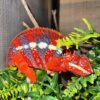

$325.00 – $699.00
Related products
Copyright © 2024 REDBOX REPTILES.

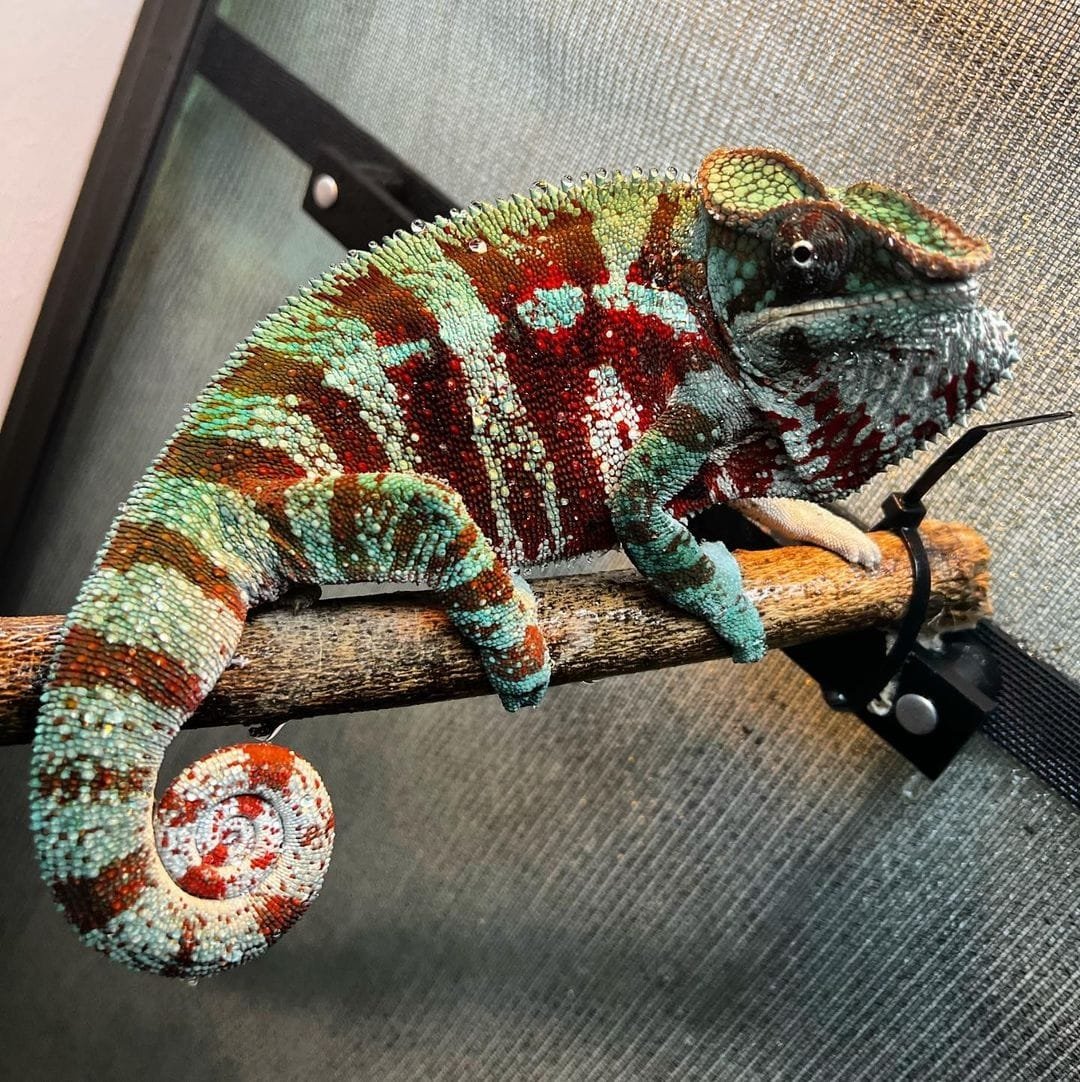

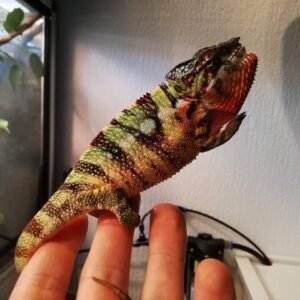
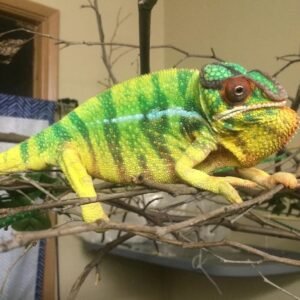
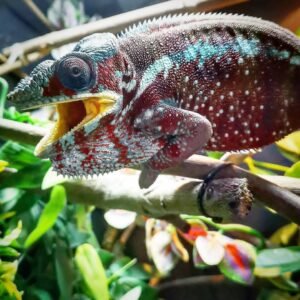

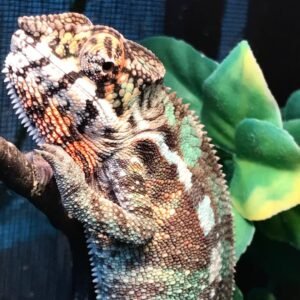

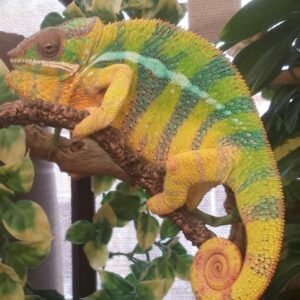

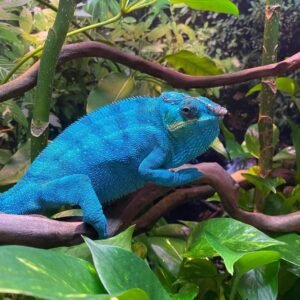

Reviews
There are no reviews yet.